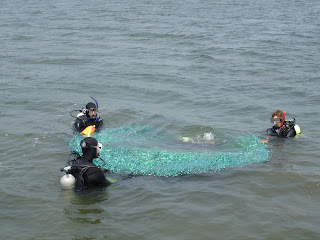

Once they were in the water, they looked great... The ribbons stood upright... They were quickly colonized by small fish like silversides and killifish... Soon the mats were colonized by other fish, like pipefifh, tautogs, cunner, and even some small flounder and sea bass, and many invertebrates, including grass shrimp, mud crabs, spider crabs, blue crabs and whelks... The mats also experienced epiphytic algal and bacterial growth and also received a fair amount of drift algae... All in all, it was very impressive and far exceeding my expectations:


I placed scallops out in these mats, 10 to a bag, to prevent predation, in order to measure scallop growth... They have been growing well, around 25 millimeters (around one inch) in 8 weeks time... These are about triple the size of when I put them in (averaging around 11-12 mm, and now between 35-40mm)... These are very exciting results, although I don't have pictures right now to show... I attempted a predation experiment with tethers, however, this wasn't very successful, as I had extremely high mortality that I could not attribute to predation...


I have also worked on spat collectors located in various locations throughout the Peconic Estuary, with some fairly exciting results... This is part of a large bay scallop restoration effort undertaken by Suffolk County and the Cornell Cooperative Extension of Suffolk County... This effort includes researches from various parts of Long Island, as well as dozens of local volunteers, to spawn scallops in captivity, grow them out in field settings and hang millions of them in lantern nets in close proximity in the hopes that having that many close together will enable them to spawn in the wild and allow larvae to recruit throughout the bays... This is the first full year with the high density of scallops in these lantern nets, although various other spawner sanctuaries have been set up for the past few years... All the data is still coming in, so nothing concrete yet, but there are some real positive signs that this type of method might be working...


Finally, I am also investigating the effectiveness of alternative habitats... I have looked at free planted and tethered scallops in alternative habitats for the past 2 summer seasons... Stay tuned for the results...





















No comments:
Post a Comment